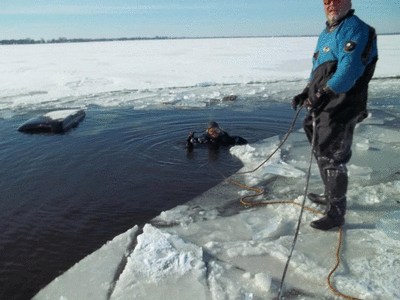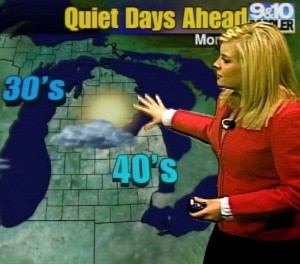
Sunk? Dive & Ice Service fishes a truck out of Lake Winnebago last month. Photo: Don Herman
On a recent morning, Don Herman flew over Wisconsin’s Lake Winnebago aboard a friend’s plane, searching for cracks and open water.
It’s just one of the ways the owner of Sunk? Dive & Ice Service gathers up-to-date information. His Oshkosh, Wis. company retrieves objects stranded on or that have fallen through thin ice – vehicles, shanties, even bodies.
Keeping an eye on Lake Winnebago ice is especially important now, Herman said.
This weekend fishermen arrive in Oshkosh, from as far away as Cheboygan, Mich. and as close as Sheboygan, Wis.
Their mission: to spear one of the nearly 50,000 sturgeon in the Lake Winnebago system.
Herman, known by most local residents as the “ice expert” for 30 years, worries now more than ever about the safety of the sportsmen.
The concern is warranted in the wake of a January 25th rescue. The Green Bay Press Gazette reported a snowmobiler broke through thin ice and spent 30 to 45 minutes in the icy waters of Lake Winnebago. Officials said the man is lucky to be alive after being hospitalized with severe hypothermia.

The “ice expert”. Don Herman established Sunk? Ice and Dive Service in 1980. Photo: Don Herman
Herman regularly measures the ice thickness and reports if it is safe on a Facebook Page with 1,300 likes and an RSS Feed.
“I’ve been keeping an eye on it,” he said. “It’s been a weird year with warmer weather and so many strong winds plus rain in the forecast.”
Herman not only pulls objects out of the ice, he assists with precautions to prevent them from falling through in the first place.
“Every day I find pressure ridges and areas of open water and mark those on a GPS map that anglers can then follow,” he said.
In some places the ice is so wide open that 75-foot portable bridges are installed to allow vehicles to travel from one side of the solid ice to the other.
Miscalculating ice conditions can be a costly mistake. Herman charges between $1,000 to $5,000 per retrieval. The cost depends on the size of the vehicle or object and the depth at which they are sunk. Considering that he retrieves 30 to 45 objects every winter, it’s a profitable business. He jokes that the work he puts into warning others of bad ice isn’t good for business.
“It doesn’t make much sense for me to tell my customers to stay off because my company thrives when they’re on it,” he said.
Communities elsewhere face similar challenges with warmer weather and weak ice. Last winter, some businesses struggled due to little or no ice coverage.
Organizers of Tip Up Town USA, an annual festival during the last two weeks of January in Houghton Lake, Mich., last year had to cancel ice fishing, said Linda Tuck, executive director of the Houghton Lake Chamber of Commerce.
The 13-15 inches of solid ice on the lake this season has not caused too many issues. But a lack of snowfall was hard on snowmobilers.
Lyman Foster, owner of Lyman’s on the Lake, a Houghton Lake bait and tackle shop since 1951, said his business is up this year despite some “bad spots, standing and open water, along with pressure cracks.

Meteorologist Katie Dupree has forecasted a strange winter in northern Michigan. Photo: Katie Dupree
“There’s no real science or pattern, every year is different,” Foster said.
Katie Dupree, a meteorologist at 9 and 10/FOX 32 news in Cadillac, Mich. said ice thickness has varied this winter. But a cold November and December froze the lakes enough that they did not completely melt during a warm January.
Dupree said depth plays a role in ice thickness; water at the shore of a lake is the first to freeze, but it also melts faster than deeper water.
For more information on what is a near-historic low for ice coverage across the region follow this link.